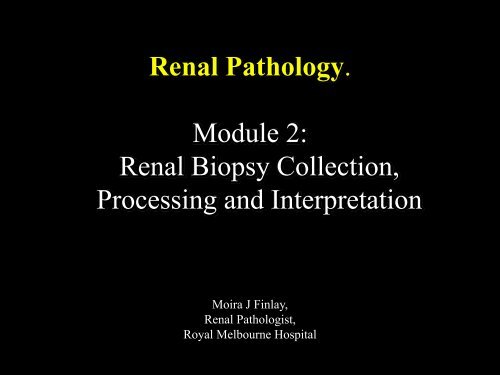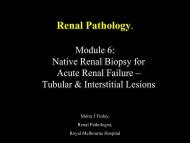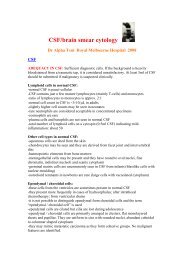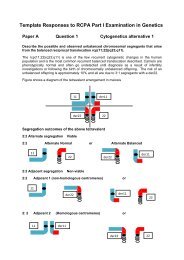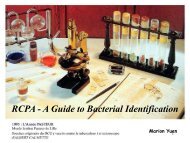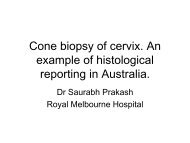PAS x40 - RCPA
PAS x40 - RCPA
PAS x40 - RCPA
You also want an ePaper? Increase the reach of your titles
YUMPU automatically turns print PDFs into web optimized ePapers that Google loves.
Laboratory handling of renal Bx:• most operators provide cores 5 to 20mm long• two passes with a 14 gauge needle may be required to obtainadequate material, especially if other investigations arerequested; an 18 gauge needle may not provide an adequatespecimen of a native or transplanted kidney• cortex is required for both native and transplant assessment• medulla is also useful in transplant Bxs• in our hospital a specially trained Medical LaboratoryScientist attends all procedures except post reperfusiontransplant Bxs, and collects the specimen, looks for glomeruliusing a dissecting microscope and divides the tissue for– light microscopy– immunohistochemistry– electron microscopy– other investigations as requested
Petri dish, filter paper moistened with sterile saline, fixatives, scalpeland orange sticks ready to receive the tissue and divide it.
Our Medical Laboratory Scientist receives the core of tissueon filter paper soaked in sterile saline for examination.
The divided tissue is place in appropriate fixative or transport medium.
Tissue for light microscopy:• describe the macroscopic appearances of the biopsy• select at least 5mm of cortex, preferably more• place it in formalin and fix• mercuric fixatives e.g. Dubos-Brazil have also beenused because deposits and nuclear detail are betterseen, but they are toxic and for Occupational Health& Safety reasons we no longer use them• process to paraffin and cut sections– 0.5μ thick for H&E and special stains– 2μ thick for Congo red and immunostains
Immunohistochemistry:• we generally perform immunoperoxidase (IP) stains on theparaffin processed tissue because the stains are durable andthe slides can be shown at meetings and stored indefinitely• some laboratories use alkaline phosphatase stains on paraffinsections because the dye is less toxic• some laboratories use immunofluorescence (IF) because it ismore sensitive but photographs are required to record stains,as the fluorescence fades• we use IF when urgent results are requested because thesections can be examined less than an hour after collection,or when Goodpasture’s disease is a possibility• for IF, select about 5mm of cortex– either transport the tissue very rapidly to the laboratory– or chill it in phosphate buffered saline (PBS)– or place the tissue in appropriate transport medium, e.g. Michel’smedium, and transport it routinely; the antigens are protected andstaining can be performed several days after collection– freeze, section and stain
A paraffin embedded renal biopsy core.
Sections & stains for light microscopy:Native renal biopsy– cut 24 serial sections• H&E stains x5• OVG x1(elastin)• <strong>PAS</strong> x2• Masson x1• AgMT x2• store the spare sectionsTransplant renal biopsy– cut 12 serial sections• H&E stains x4• OVG x1(elastin)• <strong>PAS</strong> x2• Masson x1• AgMT x2• store the spare sections
Immunohistochemical stains:Native• IgA• IgG• IgM• fibrin(ogen)• C3• C1qTransplant (Tx)• IgA• IgG• IgM• fibrin(ogen)• C3• C1q• C4d• BKV
A tray of renal biopsy slides withH&E stains, special stains and immunoperoxidase stains
Examination of H&E stains:• on low power– overall appearances• on medium power– examine glomeruli, tubules, interstitiumand vessels• on high power– look for specific lesions in glomeruli,tubules, interstitium and vessels• do not assess/score the subcapsularportion (~1mm) of transplant biopsies
Low power examination of H&E stains:• determine whether– capsule– cortex– medullaare present and in what proportions• make a preliminary assessment of– glomeruli– tubules– interstitium– vessels• an adequate transplant biopsy has≥10 glomeruli and ≥2 arteries
Medium power examination of H&E stains:• glomeruli– count the number present, including globally sclerosed glomeruli– assess size (normal around 200µ) and overall cellularity– look for crescents (≥3 layers of epithelial cells at the periphery ofthe tuft) or necrosis– look for segmental lesions• tubules– how extensive is any atrophy?– are there casts (hyaline, granular, cellular, red cell, haem)?– are there any inflammatory cells (neutrophils, lymphocytes,macrophages)– are there degenerative and regenerative changes?• interstitium– is there oedema?– is there a cellular infiltrate?– is there fibrosis?• arteries, arterioles, peritubular capillaries and veins– arterioles are usually ≤100µ in diameter– look for thrombosis, emboli, inflammation, necrosis, fibrosis
High power examination of H&E stains:• glomeruli– check thickness of sections by trying to focus up and downo if the section is too thick, there will be a range of planes– compare the diameter of the tuft with Bowman’s space– scant hyaline (bland glassy material) at the vascular pole is normalin older adults; hyaline elsewhere is abnormal– examine mesangial areaso with 0.5μ thick sections, there should be only 2 nuclei in any area;exclude the vascular pole from the cellularity assessmento matrix should be delicate, little more than the width of a mesangial cello capillary loops should be very delicate, but if obliquely sectioned, mayappear thicker than they are– endothelial cells are inconspicuous– capillary lumina should have only a few leucocytes(≤4 neutrophils/tuft) and should be patent– visceral epithelial cells should be easy to identify but not prominent;protein droplets are abnormal– parietal epithelial cells should be inconspicuous
High power examination of H&E stains:• tubules– confirm the nature of any casts(scattered hyaline casts are normal but “hard” casts, cellular casts, redcell casts and haem casts are not)– distinguish proximal and distal tubules byo luminal size (smaller in proximal tubules)o brush border (present only in proximal tubular cellso nuclear morphology (proximal tubular cell nuclei are larger and havesmall nucleoli)ocytoplasmic granularity (prominent in proximal tubules)– check that the brush border in proximal tubules is intact– if there are cytoplasmic vacuoles, assess their size and distribution– mitoses are very rare in normal renal tubules• interstitium– determine the types of cells presento normal interstitium has scant fibroblasts, lymphocytes and macrophageso neutrophils, plasma cells and lymphoid follicles are always abnormalo foamy macrophages are found in heavy/prolonged proteinuriao sometimes the kidney is infiltrated by carcinoma, lymphoma, leukaemiaor even sarcoma– consider whether amyloid or other additional stains are required
High power examination of H&E stains:• arteries– type (arcuate, interlobular or intralobular) and number– nature of thrombus or embolus– presence and severity of inflammation or necrosis– intimal thickness; if thickened, is there reduplication of elastin?– is the internal elastic lamina intact?– adventitia• arterioles– presence, location and severity of hyalinosis– presence and nature of thrombi• peritubular capillaries– normally inconspicuous, with only sparse leucocytes• veins– inflammation– congestion– thrombosis
H&E x2This is an H&E stain of a renalBx. Is any medulla present?Can you find glomeruli andarteries?
H&E x2The biopsy is all cortex butcapsule is not present.marksglomerulimarks arteriesTubules and interstitium occupythe areas between the glomeruliand vessels. Higher powerobjectives make identification ofmicroanatomy easier.
H&E x10This is a higher power view.Can you find glomeruli, anartery, arterioles, proximaltubules and distal tubules?
marksglomerulimarks an arterymarks arteriolesmarks some proximal tubulesmarks some distal tubulesH&E x10The interstitium is the pale tissuebetween the glomeruli, tubulesand vessels. Peritubularcapillaries are still hard toidentify.
H&E x10This is renal medulla. Most ofthe tubules are collecting ducts.The loops of Henlé have anattenuated epithelium.Interstitium is more abundantthan in the cortex. There is alsoa prominent capillary network.
H&E x20Can you find glomeruli, arterioles, proximal and distal tubules?
marksglomerulimarks arteriolesmarks some proximal tubulesmarks some distal tubulesEven at this magnification, the interstitium andperitubular capillaries are inconspicuous.H&E x20
H&E <strong>x40</strong>This is renal cortex. Can youfind glomeruli, proximal anddistal tubules, an arteriole,peritubular capillaries andinterstitium?
H&E <strong>x40</strong>marksglomeruli/Bowman’s capsulemarks arteriolesmarks some peritubularcapillariesmarks some proximal tubulesmarks some distal tubulesthe interstitium is scant
H&E <strong>x40</strong>Find afferent/efferent arterioles, mesangium, mesangialcells, endothelial cells, capillary loops and endothelialcells in this glomerulus and identify proximal tubules.
H&E <strong>x40</strong>marks arteriolesoutlines part of the mesangiummarks mesangial cell nucleimarks endothelial cell nucleimarks some epithelial cell nuclei
H&E <strong>x40</strong>H&E <strong>x40</strong>These glomeruli have been sectioned in different planes.H&E <strong>x40</strong>H&E <strong>x40</strong>
tubular polevascular pole
This section is too thick and it is possible to focus up and downthrough it.
peritubular capllariesarteriolessmall artery
proximal tubules withcytoplasmic eosinophilicgranules and a brush borderdistal tubules with a hobnailluminal contour and fewergranules&E <strong>x40</strong>
H&E x2H&E x10This is a biopsy from someone with chronic renal failure. Whatabnormalities can you see in the H&E stain?
some groups of tubulesare atrophicsome groups of tubulesare dilatedthere are areas of interstitialfibrosis with inflammationH&E x2
atrophic tubules in anarea of interstitialinflammation andfibrosisan artery with moderatefibroelastic intimalthickening and luminalnarrowingH&E x10H&E x10
What abnormalities can you seen in this glomerulus?H&E <strong>x40</strong>
segmental sclerosisfocal mild increasein mesangial cellsfocal moderateincrease inmesangial matrixprotein resorptiondroplets in epithelialcellsH&E <strong>x40</strong>epithelial cell proliferation (pseudocrescent)
What abnormalities can you seen in this picture?
the mesangium is expandedby amorphous eosinophilicmaterialthe wall of the artery isthickened by amorphouseosinophilic materialsome capillary loops arethickened by amorphouseosinophilic materialThis is amyloiddepositionthere is amorphouseosinophilic materialin the interstitium
Examination of <strong>PAS</strong> stains:• <strong>PAS</strong> stains glycogen and glycoproteins,therefore in the kidney, it stains– mesangium– immune complex deposits– glomerular capillary basement membranes– some luminal protein aggregates, especiallycryoglobulins– Bowmans’s capsule– tubular basement membranes– the brush border in proximal tubules– hyaline (bland glassy material) in glomeruli and arterioles– protein resorption droplets in epithelial cells– amyloid• use it to examine these structures and look forabnormalities
<strong>PAS</strong> x10
<strong>PAS</strong> <strong>x40</strong> – small artery<strong>PAS</strong> <strong>x40</strong> – glomerulus<strong>PAS</strong> <strong>x40</strong> –proximal and distal tubules<strong>PAS</strong> <strong>x40</strong> – large arteriole;note the scant hyaline
Bowman’s capsulemesangiumtubular basementmembranes<strong>PAS</strong> <strong>x40</strong> – glomerulus
<strong>PAS</strong> <strong>x40</strong><strong>PAS</strong> <strong>x40</strong>slight variations in staining from one batch to another<strong>PAS</strong> <strong>x40</strong><strong>PAS</strong> <strong>x40</strong>
<strong>PAS</strong> <strong>x40</strong>Glomerulus sectioned through the vascular pole, surrounded byBowman’s capsule; basement membranes stain magenta
What abnormalities can you seen in this glomerulus?<strong>PAS</strong> <strong>x40</strong>
segmental sclerosisfocal hyalinosisproliferationof visceralepithelial cellsadhesion betweentuft capillary loopsand Bowman’scapsule at thetubular pole<strong>PAS</strong> <strong>x40</strong>
Examination of OVG stains:• OVG stains– elastin in arteries, arterioles and veins– collagen in the interstitium• use it to examine vessels
OVG <strong>x40</strong> – interlobulararteryOVG <strong>x40</strong> –small artery/large arterioleOVG x10 – interlobular arteryOVG <strong>x40</strong> – small arteriole
Examination of Masson stains:• Masson’s stain is a trichrome stain used todemonstrate connective tissue– nuclei are blue-black– muscle is red– collagen, reticulin, and basement membranes areblue/green– elastin is pale red– fibrin is red– deposits are red– red cells are red– mitochondria are red• use it to– assess interstitial fibrous tissue– look for foci of fibrinoid necrosis– look for deposits with high dry or oil immersion lens
Masson <strong>x40</strong> –normal glomerulusMasson <strong>x40</strong> –proximal & distal tubulesMasson <strong>x40</strong> – small arteryMasson x10 – renal cortex
Masson <strong>x40</strong> –normal glomerulus
Masson <strong>x40</strong>Masson <strong>x40</strong>variations in staining from one batch to anotherMasson <strong>x40</strong>Masson <strong>x40</strong>
Masson <strong>x40</strong> –variations in staining from one batch to another
Masson <strong>x40</strong>: glomerulus with mesangial proliferation & deposits
subepithelial depositsubendothelial depositmesangial depositintramembranous depositMasson <strong>x40</strong>
AgMT <strong>x40</strong> – small arteryAgMT <strong>x40</strong> – glomerulusAgMT x10 – cortexAgMT <strong>x40</strong> – tubules
AgMT x100AgMT x100This section is too thick and is ispossible to focus up and downthrough different planesAgMT <strong>x40</strong>
AgMT x100Can you identify mesangial cells, endothelial cells and epithelial cells?
AgMT x100marks mesangialcell nucleimarks endothelialcell nucleimarks epithelialcell nuclei
This biopsy is from someonewith the nephrotic syndrome.Look for features in tubular cells.AgMT <strong>x40</strong>
tubular basement membraneproximal tubulesprotein resorptiondropletsmitochondriadistal tubulesbrush borderAgMT <strong>x40</strong>clear vacuoles, ? lipid,?damaged organelles
AgMT x100 –variations in staining from one batch to another
AgMT <strong>x40</strong>: glomerulus with deposits, mesangialproliferation, and fibrous crescent
mesangial cell nucleismallsubepithelialdepositssubendothelial depositdeposit with basementmembrane on both sidesAgMT 40fibrous crescentmesangial deposits
AgMT x100:What abnormalities can you seen in this glomerulus?
AgMT x100:there is fuzzy materialor long slender spikesaround some loopsthere is greenish-blackmaterial expanding themesangiumThis is amyloid deposition
Additional stains which may be helpful:• Gram stain if infection is suspected• IP for CMV in some transplant biopsies• if amyloid is suspected– Congo red– IP for kappa and lambda light chains– IP for amyloid A protein– IP for beta-2-microglobulin• IP to characterise an infiltrate– lymphoid cells in transplants– tumour cell phenotype• other stains as determined by the pathologist
Congo red stain showing theapple greenbirefringence of amyloid
IP SV40 <strong>x40</strong> biopsy AIP SV40 x10 biopsy AImmunoperoxidase for BK virus using antibody to SV40,with a clean background and no staining in the tubularepithelium in a biopsy of a non-infected renal transplant.
Examination of immunohistochemical stains:• these stains are used to look for abnormal proteins in glomeruli,tubular basement membranes and vessels, particularly immunecomplex deposits• there are differences between the patterns by directimmunofluorescence (IF) and immunoperoxidase (IP) methods– by IFo there may be up to moderate non-specific mesangial staining with antibodiesto IgM and C3o hyaline in glomeruli and arterioles stains with antibodies to IgM and C3o C4d may stain arteries non-specifically– by IP,o there may be up to moderate non-specific mesangial staining with antibodiesto IgM and C1qo hyaline in glomeruli and arterioles stains with antibodies to IgM and C1qo C4d stains arteries non-specifically but there is usually also non-specificmesangial staining– in both methods, there may be non-specific vascular staining with C3– enzymatic digestion of paraffin sections is required to expose antigensafter formalin fixation; this may cause background staining, especiallywith IgG
IF IgA <strong>x40</strong>Normal kidney -immunofluorescencefor IgA with a cleanbackground and nosignificant staining inthe glomerulus.
IF IgG <strong>x40</strong>Normal kidney -immunofluorescencefor IgG with a cleanbackground and nosignificant staining inthe glomerulus.
IF IgM <strong>x40</strong>Normal kidney -immunofluorescencefor IgM with a cleanbackground and lightnon-specificmesangial staining inthe glomerulus.
IF fibrin <strong>x40</strong>Normal kidney -immunofluorescencefor fibrin with a cleanbackground and faintstaining of plasma inglomerular andinterstitial capillaries.
IF C3 <strong>x40</strong>Normal kidney -immunofluorescencefor C3 with a cleanbackground andmoderate nonspecificmesangialstaining in theglomerulus.
IF C1q <strong>x40</strong>Normal kidney -immunofluorescencefor C1q with a cleanbackground and nosignificant staining inthe glomerulus.
IP IgA x10
IP IgA <strong>x40</strong>Normal kidney - immunoperoxidasefor IgA with a clean background, nostaining in the glomerulus, moderatestaining of a cast in a tubule and faintstaining of protein resorption dropletsin tubular epithelial cells
IP IgG x10
IP IgG <strong>x40</strong>Normal kidney - immunoperoxidasefor IgG with light backgroundstaining, no staining in theglomerulus, moderate staining of ahyaline cast in a tubule and lightstaining of protein resorption dropletsin tubular epithelial cells
IP IgM x10
IP IgM <strong>x40</strong>Normal kidney - immunoperoxidase forIgM with a clean background, moderategranular mesangial staining in theglomerulus (non-specific) and patchymoderate staining intimal staining in asmall artery
IP fibrin <strong>x40</strong>IP fibrin x10Normal kidney - immunoperoxidasefor fibrin with clean background,sparse granular mesangial staining inthe glomerulus (non-specific)
IP C3 x10
IP C3 <strong>x40</strong>Normal kidney - immunoperoxidasefor C3 with clean background, nostaining in the glomerulus andmoderate non-specific staining in theintima of arterioles and a small artery
IP C1q <strong>x40</strong>IP C1q x10Normal kidney - immunoperoxidasefor C1q with clean background andmoderate staining granular mesangialstaining, a non-specific finding inmany native and transplant renalbiopsies
IP IgM <strong>x40</strong>IP C1q <strong>x40</strong>Immunoperoxidase for IgM and C1qwith strong staining of hyaline inarterioles
IP kappa <strong>x40</strong>IP lambda <strong>x40</strong>Immunoperoxidase for kappalight chains showingbackground staining onlyImmunoperoxidase for lambdalight chains showingbackground staining of amyloidespecially at the periphery ofthe deposits.
IP C4d <strong>x40</strong>Normal kidney - immunoperoxidase for C4d with clean backgroundand satisfactory internal control, with granular mesangial staining inthe glomerulus and intimal staining in an artery
IP C4d <strong>x40</strong>Immunoperoxidase for C4d with clean backgroundbut strong circumferential staining in glomerularand peritubular capillaries in a recipient with anABO incompatible transplant, a common findingin ABO incompatible transplants.
IP SV40 <strong>x40</strong> biopsy BIP SV40 <strong>x40</strong> biopsy CIP SV40 <strong>x40</strong> biopsy AIP SV40 x10 biopsy A
IP SV40 <strong>x40</strong> biopsy BImmunoperoxidase for BK virus using antibody to SV40 with a cleanbackground and staining in the nuclei of many tubular epithelial cellsin a biopsy from a renal transplant with BK virus infection.
IP SV40 <strong>x40</strong> biopsy C<strong>PAS</strong> <strong>x40</strong> biopsy CImmunoperoxidase for BK virus using antibody to SV40with a clean background and lipofuscin in tubular cellcytoplasm mimicking BK virus.
Electron microscopy:• a piece of cortex about 1mm containing at least oneglomerulus is selected and placed in glutaraldehyde• the tissue is processed and embedded in plastic or resin• semi-thin sections are cut with a glass knife• the sections are stained with toluidine blue or similar stain• they are examined by light microscopy and a glomerulusis selected for examination• the block is trimmed to a “mesa” and ultrathin sectionsare cut, stained with lead citrate and uranium acetate• the ultrathin sections are examined in an electronmicroscope and photographed• tissue may also be cut out of the paraffin block andreprocessed; ultrastructural detail is poorer than when thetissue is conventionally processed but deposits can beidentified and basement membrane thickness measured
Slide with semithin sections of the plastic embedded tissue.
Toluidine blue <strong>x40</strong>Toluidine blue x2Toluidine blue x10Semithin sections of the plastic embedded tissue.
Assessment of electron micrographs:• glomerulus– overall architectureooosegmental sclerosiscollapsetuft adhesions– mesangium– capillary lumina– endothelial cells– basement membranes– epithelial cells– Bowman’s space• tubules• interstitium• vessels, including peritubularcapillaries in transplant biopsies
Assessment of the glomerulus in electron micrographs 1:• mesangial matrix and basement membrane materialhave a similar electron density and texture• identify mesangial cell nuclei and cytoplasm– there should be only one mesangial cell nucleus in anymesangial area• look for mesangial matrix abnormalities– is there an increase?– are there immune complexes deposits, which are moreelectron dense (darker) than matrix and basementmembrane material?– are there aggregates of abnormal proteins such asamyloid, fibrillary and immunotactoid deposits with atexture or substructure?
Assessment of the glomerulus in electron micrographs 2:• assess endothelial cells– evidence of cellular injury– subendothelial deposits• assess basement membranes– what is the thickness, measured from theendothelial cell to the visceral epithelial cell?Normal in adultsoo320±40nm for females370 ±45nm for males– are the lamina rara interna and externa andlamina densa normal?– are there deposits or lucent defects;• assess epithelial cells (podocytes)– are their foot processes intact?– is there evidence of cellular injury?
This is a low power electron micrograph. Can you identify a mesangial cell nucleus,mesangial matrix, capillary lumen, a red cell, three endothelial cell nuclei, basementmembrane, epithelial cell cytoplasm, epithelial cell foot processes and Bowman’s space?
mesangial matrixred cellepithelial cell foot processesBowmans’s spacemesangial matrixcapillary lumenmesangial cell nucleusendothelial cell nucleiepithelial cell cytoplasmbasement membranes
This glomerulus is normocellular, with no increase in matrix, normal endothelial cells,basement membranes of normal thickness and no deposits. There is patchy effacement(flattening) of epithelial cell foot processes but no significant abnormality.
This tissue has been reprocessedfrom paraffin.Can you identify amesangial cell nucleus,mesangial matrix, capillarylumina, three endothelialcell nuclei, basementmembranes, epithelial cellcytoplasm, epithelial cellfoot processes andBowman’s space? Howthick are the basementmembranes? What are theeffects of reprocessing?
mesangial matrixepithelial cellfoot processesmesangial matrixcapillary lumenmesangial cell nucleusendothelial cell nucleiepithelial cell cytoplasmbasement membranes
This glomerulus has normalnumbers of mesangial cells,no increase in mesangialmatrix, normal endothelialcells, basement membranesof normal thickness (about350nm), no deposits andnormal epithelial cells withintact foot processes. Thecell membranes have beenlost through paraffinprocessing but nuclearchromatin is well preservedand the structure ofmesangial matrix andbasement membranes isreasonably intact.
The Banff Classification of Renal Allograft Pathology:• the first International Banff InternationalConference on Allograft Pathology was held inBanff, Canada in 1991; conferences have been heldevery two years since then• the scoring system published after the 1997conference is the foundation of our assessment ofrenal transplant biopsies; it has been modified twice• the system was designed to standardise transplantbiopsy assessment for clinical trials and particularlyemphasises allograft rejection, but we find it usefulfor all allograft biopsies• it defines scores for acute and chronic lesions inglomeruli, tubules, interstitium and vessels,categorises the process and grades its severity
Specimen adequacy and lesion scoring (Banff ’97/07):• specimen adequacy• quantitative criteria for tubulitis (t)• quantitative criteria for mononuclear cell interstitialinflammation (i)• quantitative criteria for the early type of allograftglomerulitis (g)• quantitative criteria for arteriolar hyaline thickening (ah)• quantitative criteria for intimal arteritis (v)• quantitative criteria for peritubular capillaritis (ptc)• quantitative criteria for allograft glomerulopathy (cg)• quantitative criteria for interstitial fibrosis (ci)• quantitative criteria for tubular atrophy (ct)• quantitative criteria for fibrous intimal thickening (cv)• quantitative criteria for mesangial matrix increase (mm)• C4d scoring
Specimen adequacy(a necessary prerequisite for numerical coding):unsatisfactory no glomeruli or arteriesmarginaladequate1-9 glomeruli with an artery≥10 glomeruli with at least 2 arteriesMinimum sampling7 slides 3 H&E, 3 <strong>PAS</strong> or silver stains and 1trichrome
Quantitative criteria for tubulitis (t) score:t0t1t2t3no mononuclear cells in tubulesfoci with 1-4 cells/tubular cross section or10 tubular cellsfoci with 5-10 cells/tubular cross sectionor 10 tubular cellsfoci with >10 cells/tubular cross section or10 tubular cells, or the presence of at leasttwo areas of tubular basement membranedestruction accompanied by i2/3 and t2tubulitis elsewhere in the biopsy
Quantitative criteria for mononuclear cellinterstitial inflammation (i) score:i0i1i2i3no or trivial interstitial inflammation(50% of parenchyma inflamedindicate presence of remarkable numbers ofeosinophils, neutrophils or plasma cells(specify which) with asterisk* on i
Quantitative criteria for the early type ofallograft glomerulitis (g) score:g0g1g2g3no glomerulitisglomerulitis in a minority of glomerulisegmental or global glomerulitis in about25-75% of glomeruliglomerulitis (mostly global) in all oralmost all glomeruli
Quantitative criteria for arteriolar hyalinethickening (ah) score:ah0no <strong>PAS</strong> positive hyaline thickeningah1 mild to moderate <strong>PAS</strong> positive hyalinethickening in at least one arterioleah2 moderate to severe <strong>PAS</strong> positive hyalinethickening in more than one arterioleah3 severe <strong>PAS</strong> positive hyaline thickening inmany arteriolesindicate arteriolitis (significance unknown) withasterisk* on ah
Quantitative criteria for intimal arteritis (v) score:v0no arteritisv1 mild to moderate arteritis in at least one arterialcross sectionv2 severe intimal arteritis with at least 25% luminalarea lost in at least one arterial cross sectionv3 arterial fibrinoid change and/or transmural arteritiswith medial smooth muscle necrosisnote number of arteries present and number affected;indicate infarction and/or interstitial haemorrhage by anasterisk* (with and level ‘v’ score)
Quantitative criteria for peritubular capillaritis(ptc) score:ptc0ptc1ptc2no significant cortical ptc, or 10luminal inflammatory cellscomment on the composition (mononuclear cells versusneutrophils) and extent (focal, ≤50% versus diffuse, >50%) of ptc
Quantitative criteria for allograftglomerulopathy (cg) score:cg0no glomerulopathy, double contours in 50% of peripheralcapillary loops in non-sclerotic glomerulinote number of glomeruli and number sclerotic
Quantitative criteria for interstitial fibrosis(ci) score:ci0 interstitial fibrosis in up to 5% of cortical areaci1 mild interstitial fibrosis in 6-25% of corticalareaci2 moderate interstitial fibrosis in 26-50% ofcortical areaci3 moderate interstitial fibrosis in >50% ofcortical area
Quantitative criteria for tubular atrophy(ct) score:ct0 no tubular atrophyct1 tubular atrophy in up to 25% of thearea of cortical tubulesct2 tubular atrophy involving 26-50%of the area of cortical tubulesct3 tubular atrophy of >50% of thearea of cortical tubules
Quantitative criteria for fibrous intimalthickening (cv) score:cv0no chronic vascular changecv1 vascular narrowing of up to 25% of luminal area byfibrointimal thickening of arteries ± breach of internal elasticlamina or presence of foam cells or occasional mononuclearcells*cv2 increased severity of above changes with 26-50% narrowingof vascular luminal area*cv3 severe vascular changes with >50% narrowing of vascularluminal area* in most severely affected vessel; note if lesions characteristic ofchronic rejection (elastica breaks, inflammatory cells or fibrosis)are seen
Quantitative criteria for mesangial matrixincrease (mm)* score:mm0 no mesangial matrix increasemm1 up to 25% of non-sclerotic glomeruli affected (at leastmoderate matrix increase)mm2 26-50% of non-sclerotic glomeruli affected (at leastmoderate matrix increase)mm3 >50% of non-sclerotic glomeruli affected (at least moderatematrix increase)* the threshold criterion for the moderately increased ‘mm’ is theexpanded mesangial interspace between adjacent capillaries; if thewidth of the interspace exceeds two mesangial cells on average inat least two glomerular lobules, the ‘mm’ is moderately increased
C4d scoring :% biopsy area(cortex and/ormedulla)C4d0 negative 0% negative negativeC4d1 minimal 1- 50% positive positiveOnly linear circumferential staining is considered positive.Assess a minimum of 5 high power fields in cortex or medullawithout scarring or infarction.Focal IP staining with ptc/glomerulitis is probably significantand may be equivalent to diffuse staining by IF.IFIP
Diagnostic categories for renal transplantbiopsies Banff ’97, modified ’071. Normal2. Antibody-mediated changes3. Borderline changes4. T-cell-mediated rejection (TCMR)[formerly Acute/active cellular rejection]5. Interstitial fibrosis and tubular atrophy[formerly Chronic/sclerosing allograftnephropathy]6. Changes not considered to be due to rejection
2. Antibody-mediated changes:may coincide with categories 3, 4, 5 & 6due to documented circulating anti-donor Ab, and C4d3 or allograft pathology• C4d deposition without morphologic evidence of active rejection– C4d+, presence of circulating anti-donor Abs, no signs of acute or chronicTCMR or AbMR (i.e. g0, cg0, ptc0, no ptc lamination)– cases with simultaneous borderline changes or ATN are considered asindeterminate• acute antibody-mediated rejectionC4d+, presence of circulating anti-donor Abs, morphologic evidence ofacute tissue injury, such as (Type/Grade):I. ATN-like minimal inflammationII. capillary and or glomerular inflammation (ptc/g >0) and/orthrombosesIII. arterial - v3• chronic active antibody-mediated rejectionC4d+, presence of circulating anti-donor antibodies, morphologic evidenceof chronic tissue injury, such as glomerular double contours and/orperitubular capillary basement membrane multilayering and/or interstitialfibrosis/tubular atrophy and/or fibrous intimal thickening in arteries
3. Borderline changes:• suspicious for acute TCMR• may coincide with categories 2, 5 & 6• this category is used• when no intimal arteritis is present• but there are foci of tubulitis (t1, t2 or t3)with minor interstitial infiltration (i0 or i1)• or interstitial infiltration (i2, i3) with mild(t1) tubulitis
4. T-cell-mediated rejection (TCMR):may coincide with categories 2, 5 & 6• acute T-cell-mediated rejection (Type/Grade:)IA. Cases with significant interstitial infiltration (>25% of parenchymaaffected, i2 or i3) and foci of moderate tubulitis (t2)IB. Cases with significant interstitial infiltration (>25% of parenchymaaffected, i2 or i3) and foci of severe tubulitis (t3)IIA.Cases with mild-to-moderate intimal arteritis (v1)IIB. Cases with severe intimal arteritis comprising >25% of the luminalarea (v2)III. Cases with ‘transmural’ arteritis and/or arterial fibrinoid change andnecrosis of medial smooth muscle cells with accompanyinglymphocytic inflammation (v3)• chronic active T-cell-mediated rejection‘chronic allograft arteriopathy’ (arterial intimal fibrosis withmononuclear cell infiltration in fibrosis, formation of neo-intima)
5. Interstitial fibrosis and tubular atrophy:• no evidence of any specific aetiology(may include nonspecific vascular andglomerular sclerosis, but severity graded bytubulointerstitial features)• GradeI. Mild interstitial fibrosis and tubular atrophyII.(50% of cortical area)
6. Other:• changes not considered to be due to rejection• acute and/or chronic e.g.– acute tubular necrosis– de novo/ recurrent glomerulonephritis– post transplant lymphoprolferative disorder– etc• may include isolated g, cg or cv lesions andcoincide with categories 2, 3, 4 and 5)
The transplant biopsy report:• the recommended form is a descriptivenarrative followed by the Banff ’07 codesin parentheses• initial categorisation should be based solelyon pathological changes• integrate with clinical data as a second step• more than one diagnostic category may beused if appropriate
References:• Banff 07 Classification of Renal Allograft Pathology:Updates and Future DirectionsSolez et alAmerican Journal of Transplantation 2008; 8: 753–760• Non-Neoplastic Kidney Diseasesd’Agati, Jennette & Silva(AFIP Atlas of NonTumor Pathology #4)ARP Press 2005• Diagnostic Atlas of Renal PathologyFogo & KashgarianElsevier Saunders 2005• Theory and Practice of Histological Techniques,4 th EditionBancroft & StevensChurchill Livingstone 1996• Renal Pathology, 2 nd EditionDischeOxford Medical Publications 1995
Acknowledgements:• Staff of the Anatomical Pathology Department,Royal Melbourne Hospital, particularly FrankFeleppa and Rosa Agostino• Staff of the Electron Microscopy Unit atMelbourne University, particularly AnnaFriedhuber• Professor Priscilla Kincaid Smith & ProfessorJohn Dowling, former pathologists at the RoyalMelbourne Hospital• Ian Burchell and Marie Cock, former scientificstaff in the Anatomical Pathology Department,Royal Melbourne Hospital


